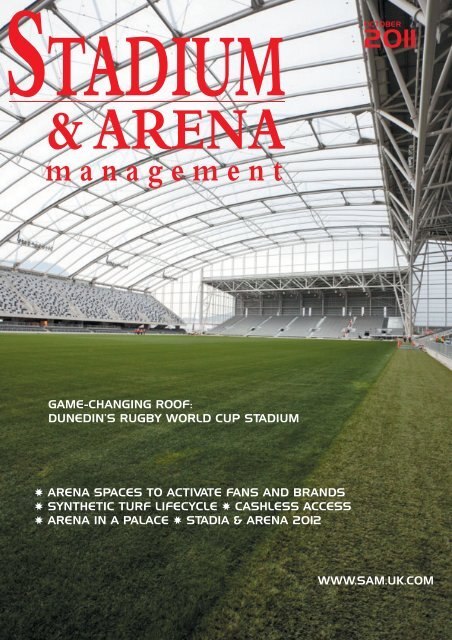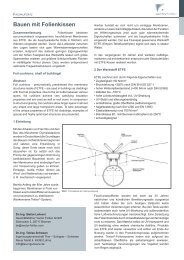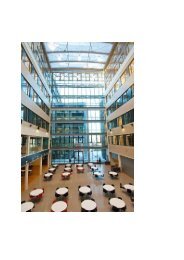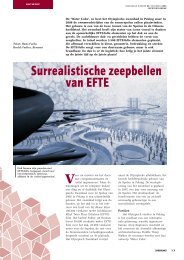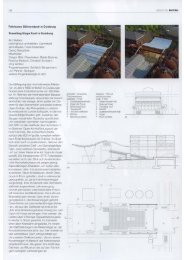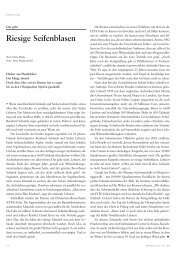You also want an ePaper? Increase the reach of your titles
YUMPU automatically turns print PDFs into web optimized ePapers that Google loves.
GAME-CHANGING ROOF:<br />
DUNEDIN’S RUGBY WORLD CUP STADIUM<br />
✸ ARENA SPACES TO ACTIVATE FANS AND BRANDS<br />
✸ SYNTHETIC TURF LIFECYCLE ✸ CASHLESS ACCESS<br />
✸ ARENA IN A PALACE ✸ STADIA & ARENA 2012<br />
OCTOBER<br />
2011<br />
WWW.SAM.UK.COM
Venue design and construction – roofs<br />
Roof revolution<br />
<strong>New</strong> architectural <strong>forms</strong> and new materials are leading to stadiums which better<br />
match the needs of owners and spectators, as cost goes down and comfort goes up.<br />
When it comes to customer<br />
comfort, what’s more important<br />
than the stadium roof? It keeps<br />
the rain, wind and sun off the<br />
seating areas so that spectators can enjoy the<br />
entertainment. It protects the rest of the<br />
stadium fabric and it can be an iconic structure<br />
for those walking up or watching an aerial shot<br />
on TV. First things first: the roof should be safe.<br />
Stadium roof collapses this year are a warning<br />
to the industry: at FC Twente’s De Grolsch Veste<br />
stadium (one death, 16 injured) and at<br />
Wollongong’s WIN Stadium, where (according<br />
to local newspaper reports) a recently installed<br />
roof buckled under gale-force winds.<br />
History suggests that where roofs are<br />
specified, they are enclosing more and more of<br />
the stadium. The ’dome arenas’ showed the<br />
way during the 1990s. Built by Mitsubishi<br />
Heavy Industries in Japan, domes housed<br />
ballparks (Tokyo and Fukuoka Domes) with<br />
retractable seating and pitching mounds to<br />
allow other events to take place, such as cycling<br />
and concerts. Mitsubishi’s technology included<br />
the bicycle racing banks, stage equipment and<br />
rigging machinery as well as the retractable<br />
roof drive equipment.<br />
When the Waldstadion in Frankfurt was<br />
finally redeveloped for the 2006 World Cup, its<br />
signature roof was constructed from a cablesuspended<br />
ring of fibreglass, similar to<br />
stadiums in Hamburg and Berlin, but this time<br />
around 80,000ft 2 of the inner roof was<br />
removable. An inner network of tensioned<br />
cables also suspended a cube with LED screens.<br />
BC Pavilion Corporation (PavCo) in<br />
Vancouver has specified a new roof as part of<br />
Right: Forsyth Barr Stadium, Dunedin. The<br />
roof and natural turf combination is the<br />
result of extensive research. Copyright<br />
reproduced courtesy of <strong>Vector</strong> <strong>Foiltec</strong>.<br />
32 STADIUM & ARENA MANAGEMENT www.sam.uk.com October 2011
the rejuvenation of the BC Place stadium that<br />
was previously covered by an air-supported<br />
structure. PavCo has quoted energy cost savings<br />
of $350,000 or 25% per year and maintenance<br />
cost savings of $100,000 per year. The roof is<br />
suspended from 36 masts, each 50 metres in<br />
length and weighing approximately 240<br />
tonnes. The retractable centre portion of the<br />
roof is made of flexible Tenara fabric. The outer<br />
permanently-fixed portion of the roof is made<br />
of PTFE coated fibreglass, and covers all of the<br />
seating in all weather conditions.<br />
Architects have employed materials such as<br />
fibreglass to design very different looking roofs.<br />
Stadiums in South Africa, for the FIFA World Cup,<br />
and in Poland for Euro 2012 are just some of<br />
the latest examples. Texlon, <strong>Vector</strong> <strong>Foiltec</strong>’s<br />
invention which employs ETFE (ethylene<br />
tetrafluoroethylene) for cladding, looked very<br />
interesting for some stadium design work that<br />
architect Populous was carrying out for rugby<br />
stadiums in <strong>New</strong> Zealand in preparation for the<br />
Rugby World Cup.<br />
Texlon allows natural light to penetrate and<br />
it therefore held out the hope of growing<br />
natural grass under a roof. The client’s team of<br />
experts wanted to know more. Angus Macleod,<br />
engineer at <strong>Vector</strong> <strong>Foiltec</strong>, explains: ”We<br />
designed and built a fully enclosed test rig with<br />
walls and a roof and tested various grasses.”<br />
Real rugby players and a mechanical scrum<br />
were used to see how the turf held up.<br />
Although the turf was lush and grew faster<br />
under the Texlon ETFE than outside, it was<br />
determined that the roots needed the help of a<br />
Desso Grassmaster system.<br />
The upshot of this early work is that<br />
Populous, in association with local firm Jasmax,<br />
designed the Forsyth Barr Stadium as the<br />
world’s first fully covered stadium with a natural<br />
grass pitch. It has 20,000 permanent seats, and<br />
11,000 temporary for the World Cup. The design<br />
and engineering of the roof allows optimal<br />
solar light transmission while natural ventilation<br />
is provided by raised facades. The supporting<br />
structure spans 105 meters with an internal<br />
roof clearance of 37 metres. Five trusses stretch<br />
from the north stand to a transfer truss above<br />
the metal deck roof of the south stand as the<br />
main support.<br />
The roof cladding is made up of inflated<br />
cushions of Texlon, which first found<br />
international acclaim when used on the 2001<br />
Eden Project, a series of gardens under domes<br />
in Cornwall, England. There are now 1,000<br />
projects worldwide using this technology,<br />
which was subsequently supplied by <strong>Vector</strong><br />
<strong>Foiltec</strong> for use in St Jacobs Stadium in Basel and<br />
the Olympic Aquatics Centre in Beijing.<br />
”In Carisbrook, spectators stood and froze,”<br />
says Macleod, referring to the previous<br />
incarnation of the stadium. ”It was lowering<br />
attendance at games. Stadium design is about<br />
winning people back from in front of their TVs<br />
October 2011 www.sam.uk.com STADIUM & ARENA MANAGEMENT 33
in their lounges, so we have to create a nice<br />
atmosphere and a comfortable experience.”<br />
Anyone who viewed games at the stadium in<br />
the recent Rugby World Cup will have noticed<br />
the fans jumping up and down in their<br />
shirtsleeves and drinking cold beer in what is<br />
the middle of winter in <strong>New</strong> Zealand.<br />
Texlon is about big numbers – 100,000m 2 on<br />
the water cube – and small – weighing one<br />
kilogram per square metre. Forsyth Barr<br />
Stadium has 20,500m 2 in the roof and Eden<br />
Park, Auckland, has used 10,000m 2 in the<br />
façade which is part of its new south stand.<br />
Macleod says the material’s lifespan is as yet<br />
unknown. After 20 years of maintenance,<br />
<strong>Vector</strong> <strong>Foiltec</strong> has detected no change in its<br />
optical or mechanical properties.<br />
The material is smooth and so dirt washes<br />
off easily and the cushions, which are five<br />
metres by 20 metres, won’t pop out of their<br />
framework in the event of an earthquake. If a<br />
cushion were to be damaged, the lightweight<br />
material would float to the ground. It has low<br />
embodied energy. Macleod assures that,<br />
although Texlon ETFE uses some fossil fuels in<br />
its production, it’s a byproduct of a mining<br />
process and doesn’t leave any harmful waste. It<br />
is also recyclable. If a building one day pulls<br />
down the Texlon ETFE – it hasn’t happened yet<br />
– the material can be taken back by <strong>Vector</strong><br />
<strong>Foiltec</strong>, melted down and re-used.<br />
”It’s very exciting,” sums up Macleod. ”You<br />
can grow natural turf pitches under a Texlon<br />
ETFE roof. Couple that with the material being<br />
lightweight and easy to adapt architecturally<br />
and you have to ask ’why not?’ It could be a<br />
revolution in stadium design and I’m told it’s the<br />
cheapest stadium in <strong>New</strong> Zealand judged by<br />
NZ$ per square foot.”<br />
”The permanent roof means Forsyth Barr is<br />
a true hybrid between a highly efficient, well<br />
functioning football/rugby stadium and an<br />
entertainment venue,” says Richard Breslin,<br />
Populous Senior Principal and Project Director of<br />
Forsyth Barr stadium. ”Research by many<br />
people has created this final concept of a<br />
natural grass pitch growing under a permanent<br />
roof structure. The fans are protected from the<br />
elements and the action goes on whatever the<br />
weather.” Breslin also thinks the rectangular<br />
design will change the way we view the live<br />
game: ”The angled seating pitch and enclosed<br />
roof will mean spectators are closer to the<br />
action than ever before and the atmosphere<br />
will be fantastic. I was there recently, and even<br />
though there was no game on, the sense of<br />
enclosure made the hairs stand up on the back<br />
of my neck.”<br />
Populous Associate Principal, Ron Van Sluijs,<br />
Project Architect of Forsyth Barr stadium during<br />
its design phase, says: ”The new roof means<br />
Top and middle: Forsyth Barr Stadium kicked off with games in the Rugby World Cup. It<br />
will prove its multi-purpose credentials in December with a first concert.<br />
Bottom: Eden Park, also a Rugby World Cup venue, has a new façade made from Texlon<br />
ETFE. Photos copyright reproduced courtesy of <strong>Vector</strong> <strong>Foiltec</strong>.<br />
34 STADIUM & ARENA MANAGEMENT www.sam.uk.com October 2011
Innovative<br />
Stadia Architecture<br />
<strong>Vector</strong> <strong>Foiltec</strong> is revolutionising sport and stadia<br />
design with the world’s first permanently covered<br />
natural turf pitch, the Forsyth Barr Stadium.<br />
International market leader and pioneer of Texlon ®<br />
ETFE, <strong>Vector</strong> <strong>Foiltec</strong> boasts 30 years of experience<br />
at the forefront of specialist design and ETFE<br />
technology. We offer our clients a complete service<br />
with unprecedented expertise.<br />
Our extensive portfolio includes The National<br />
Aquatic Centre, Beijing, The Khan Shatyr<br />
Entertainment Centre, Kazakhstan, Eden Park<br />
Stadium, <strong>New</strong> Zealand, and St. Jakob Stadium,<br />
Basel.<br />
www.vector-foiltec.com<br />
4<br />
1<br />
5<br />
1 National Swimming Center<br />
Beijing (CN), 2007<br />
2 Stadion St. Jakob-Park<br />
Basel (CH), 2009<br />
© Andreas Braun<br />
3 Eden Park Stadium<br />
Auckland (NZ), 2010<br />
© Julian Apse<br />
4 2022 Showcase Stadium<br />
Doha (QA), 2010<br />
5 Eden Park Stadium<br />
Auckland (NZ), 2010<br />
Forsyth Barr Stadium<br />
Dunedin (NZ), 2011<br />
2<br />
3
we can maintain a constant temperature and<br />
grow a stronger grass which will not become<br />
boggy because it will never rain, snow, or hail<br />
inside the stadium during a game at Forsyth<br />
Barr. This roof material allows for 90% of<br />
sunlight to still reach the pitch, along with UV<br />
light and fresh air.”<br />
Project Architect during the construction<br />
phase at Forsyth Barr, Populous Associate<br />
Jochem Veerman adds that the sectional profile<br />
of the stadium was carefully designed to<br />
maximise solar penetration onto the field as<br />
well as the natural ventilation:<br />
”The ETFE covers the roof and parts of the<br />
façades. The stands on the northern end are<br />
lower to allow maximum sunlight onto the<br />
pitch and the end facades are raised five<br />
metres so the stadium is open at these points,<br />
allowing natural ventilation of the grass, and to<br />
ensure spectators do not feel enclosed. There<br />
are also ventilation slots at a high level to<br />
ensure air circulates properly.”<br />
<strong>New</strong> <strong>forms</strong><br />
Thinking about the real needs of stadium<br />
spectators can result in interesting architectural<br />
<strong>forms</strong>, according to Mott Macdonald Divisional<br />
Director Leon Higgins.<br />
Roof design in hot countries, such as the<br />
Middle East, needs new thinking, he says: ”They<br />
don’t need an umbrella, they need a sun<br />
shade.” FIFA’s guidelines designate a roof to the<br />
edge of the seating but this isn’t always<br />
appropriate. Mott Macdonald Associate Paul<br />
Officer encourages architects to take a rational<br />
approach: ”It is sometimes more appropriate to<br />
relax the compliance with the guidelines and<br />
focus more on designing for<br />
the actual environmental conditions at the site.”<br />
Future-proofing customer comfort<br />
Mott Macdonald’s engineers consult on many<br />
stadium projects around the world. The company<br />
is currently working with Pattern Architects’<br />
Dipesh Patel, who has introduced a profile roof<br />
that provides complete shading at kick-off time in<br />
the afternoon in August for stadiums in the Middle<br />
East. This has resulted in a different, assymetrical<br />
form. Often this form is used to save money but<br />
Patel’s design is about achieving the right<br />
conditions for the environment.<br />
Patel explains that his design came about<br />
on a job which started out as a moving roof. ”To<br />
keep the aperture small enough to have a<br />
moving roof, you really struggle with getting<br />
enough daylight through.” The debate around<br />
the roof design included using artificial turf and<br />
the use of different roof materials.<br />
”It’s essentially a parasol – that’s the best<br />
way to describe it,” says Patel. ”It provides a<br />
balance of shading for spectators, but enough<br />
light during the rest of the day for the grass to<br />
grow. We’ve looked at several materials and<br />
settled on a polycarbonate and PVC sandwich,<br />
and that’s more about what it looks like. It’s<br />
effectively solid, which is good for the people<br />
underneath.”<br />
Officer points out that the moving roof on<br />
Wembley is principally about getting light to<br />
the pitch, a problem that hasn’t been<br />
completely solved by translucent materials. He<br />
suggests that Patel’s parasol is a less brutal<br />
approach to solving the shading versus grassgrowing<br />
conundrum. ”Moving roofs are big and<br />
heavy and expensive. You need a lot of<br />
steelwork to take the load which is<br />
concentrated on two lines where the rails are<br />
located. At Wembley we kept it down a bit by<br />
spreading the load around more panels.”<br />
Patel thinks that the ”firework roof<br />
structure” still has its place but that architects<br />
Holding things together: High Torque<br />
Jubilee Clips (made by L Robinson & Co) on<br />
the roof of the new Forsyth Barr Stadium,<br />
Dunedin, <strong>New</strong> Zealand. Auto Agencies<br />
(<strong>New</strong> Zealand distributor) supplied 208<br />
clips at short notice to the roof contractors.<br />
take a more holistic approach than a decade<br />
ago. ”A roof can still be iconic and striking, but<br />
through its overall form rather than the finery of<br />
the diagram.” For simple grandstand shapes,<br />
the cantilever is generally the most costeffective<br />
of the self-supporting structures. Patel<br />
agrees that these structures are cost-driven and<br />
that it’s difficult to scale down the <strong>forms</strong><br />
possible in larger stadiums, such as those he<br />
used to design City of Manchester Stadium, to<br />
smaller capacity venues.<br />
<strong>Vector</strong> <strong>Foiltec</strong> supplied Texlon to the showcase stadium built by the Qatar 2022 bid committee for the FIFA World Cup. The bid required<br />
looking into a future of comfortable and energy efficient stadiums hosting athletes and fans in summer. A combined team of architects,<br />
engineers and environmental services at Arup managed the project and Edwin Shirley Staging constructed the prototype. <strong>Vector</strong> <strong>Foiltec</strong><br />
worked with David Dexter Associates structural engineers to clad<br />
Photo: copyright reproduced courtesy of <strong>Vector</strong> <strong>Foiltec</strong>.<br />
the moving roof and two opening/closing façades.<br />
”The cladding is Texlon ETFE combined with tensile fabric shading<br />
and the design is all about controlling heat gain out and in,” says<br />
Stephen Jones, Design Director at <strong>Vector</strong> <strong>Foiltec</strong>.<br />
The principle is to open at night to cool the seating areas and base<br />
of the walls, closing in the day to keep out the heat. Jones explains<br />
that the Texlon ETFE is light and therefore doesn’t put big load or<br />
energy demands on the engineering needed to move the roof and<br />
façade structures.<br />
The stadium met Arup’s performance criteria and Qatar won the bid<br />
so the project succeeded in various ways.<br />
”We learned valuable lessons about value engineering our<br />
solution,” says Jones. ”I hope that Texlon ETFE is deemed applicable<br />
for this kind of stadium application.”<br />
36 STADIUM & ARENA MANAGEMENT www.sam.uk.com October 2011


